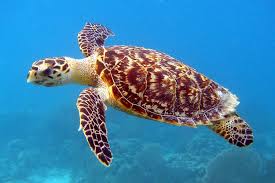The Leatherback Sea Turtle, a marvel of the marine world, is the largest of all living turtles and stands as a testament to the power and beauty of nature. Known for their distinctive leathery shells, these magnificent creatures are not only a testament to evolution’s creativity but also an important participant in maintaining the health of our planet’s oceans.
Migratory Behavior and Remarkable Adaptations
- Migratory Behavior: Many animal species, particularly birds, exhibit migratory behavior, undertaking long-distance journeys in response to seasonal changes. This migration is often driven by the search for more abundant food resources or suitable breeding conditions. These journeys can span thousands of miles, showcasing the remarkable resilience and navigational skills of these creatures.
- Remarkable Adaptations: Adaptation is a crucial survival tool in the animal kingdom. For instance, the Arctic fox changes its fur color to white during winter for camouflage in the snow. Similarly, desert animals like camels have adapted to survive extreme heat and scarcity of water. Their hump stores fat, which can be used as both a food source and a water source when resources are scarce. These adaptations highlight the incredible flexibility and survival strategies of wildlife.
Global Distribution and Population Status
- Global Distribution: Species can be found spread across various regions globally. Depending on the specific species, they may thrive in diverse environments from tropical rainforests and arid deserts to icy polar regions and temperate zones. The distribution often depends on the species’ adaptability to different climate conditions, food availability, and potential threats.
- Population Status: Population status of a species refers to the current size and health of its population. Many factors influence this, including birth rates, death rates, immigration, and emigration. The population status can often indicate the species’ vulnerability or risk of becoming endangered or extinct. Regular monitoring and research are vital for maintaining healthy populations and ensuring biodiversity.
Threats to Survival
- Climate Change: Rapid changes in global climate patterns pose serious threats to the survival of many species. Extreme weather events, shifting temperature norms, and rising sea levels can degrade habitats and disrupt ecosystems.
- Habitat Destruction: Development of infrastructure, deforestation, and resource extraction lead to habitat loss, a major threat to the survival of wildlife.
- Overexploitation: Overhunting, overfishing, or overharvesting can deplete populations of animals and plants, threatening their survival.
- Pollution: Contamination of air, water and soil by human-produced waste can harm and even kill animals and plants.
- Invasive Species: Non-native species can outcompete native species for resources, potentially leading to their extinction.
Conservation Efforts and Initiatives
- Protected Areas: Many countries establish protected ecological zones or reserves to preserve natural habitats and prevent destruction caused by human activities. These regions can include national parks, wildlife sanctuaries, and marine protected areas.
- Species Recovery Programs: Conservationists often implement species recovery programs to prevent the extinction of endangered species. These initiatives may involve captive breeding, habitat restoration, and release programs.
- Community-Based Conservation: Many initiatives strive to involve local communities in conservation efforts. These programs may provide education and resources to communities, empowering them to protect their local ecosystems.
- Sustainable Practices: Conservation can also take the form of promoting sustainable lifestyle practices. These can include encouraging the use of renewable energy resources, promoting waste reduction and recycling, and advocating for sustainable agriculture and fishing practices.
- Policy and Legislation: Policymakers can contribute to conservation efforts by implementing environmental protection laws and regulations. These laws can limit harmful activities such as deforestation, overfishing, and pollution, and enforce penalties for violations.
- Research and Education: Conducting research to understand ecological systems and educating the public about the importance of biodiversity and the threats posed by human activities are both crucial elements of conservation.

Leatherback Appearance, Behavior, and Diet
- Appearance: The Leatherback Turtle is the largest turtle species, growing up to 6 feet in length. Its shell, or carapace, is leather-like rather than hard, as in other turtles. The carapace is elongated and streamlined, marked by seven distinct ridges running the length of the animal and tapering to a blunt point at the tail. Their coloration is primarily black, with varying amounts of white spotting.
- Behavior: Leatherbacks are solitary creatures that spend most of their life in the open ocean. Known for their long-distance migratory behavior, they can travel more than 10,000 miles each year. Unlike other sea turtles, leatherbacks are capable of withstanding colder water temperatures and can dive to depths of 4,200 feet.
- Diet: Leatherback Turtles primarily feed on jellyfish, but their diet can also include other soft-bodied organisms such as tunicates and cephalopods. Their throat and scissor-like jaws are specially adapted to consume this diet. Despite their large size, leatherbacks cannot eat hard foods due to the lack of crushing jaws.
Lifespan, Reproduction, and Nesting Habits
- Lifespan: The lifespan of animals varies greatly depending on their species. Some species such as mayflies have a lifespan of only one day, while others like Galapagos tortoises can live for more than 150 years.
- Reproduction: Reproduction methods also vary widely among animals. Some animals, like mammals, reproduce sexually and give live birth to their young. Others, like birds and most reptiles, lay eggs, which the parents often care for until they hatch.
- Nesting Habits: Nesting habits are diverse as well. Birds are known for building nests in trees or on the ground, where they lay and incubate their eggs. Other animals, such as turtles, bury their eggs in the sand and leave them to hatch on their own. Beavers build intricate lodges of sticks and mud as their nests.
Conclusion
- Technology has become an integral part of education, enhancing the learning experience and making it more interactive.
- It transcends geographical barriers, allowing a seamless exchange of knowledge between teachers and students across the globe.
- Outdoor activities provide not only physical benefits but also contribute to mental and emotional wellness.
- Activities such as hiking, cycling, or swimming can significantly improve cardiovascular health and overall physical strength.


